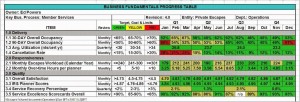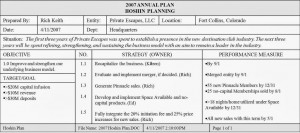Planning is easy. Execution is hard. How can a monthly meeting keep an organization persistently on track to achieve its goals?
Nobody likes meetings, including me. People perceive them as time-wasters. Many have gone to “no PowerPoint” talks, got rid of chairs, or eliminated meetings entirely. In my view, these are extreme measures. Meetings serve a purpose. They provide important venues to communicate, learn, and make decisions. Yes, cut back on the number of meetings, but make the ones you keep more productive.
I think the best meeting agenda is called a Monthly Business Review (MBR). It’s a formal meeting (yes, preparation is required) designed to check progress on key plans, projects, and business performance. What makes it the best? Unlike other meetings, the MBR ensures the organization executes its business plan. The alternative, of course, is to do what most companies do: make a plan, and after a few weeks just go back to what people were doing before the planning session.
For an MBR, all functional heads and the CEO attend. A scribe and a timekeeper are assigned. Each manager has 15 minutes and may present only three slides. During the meeting, the scribe records issues and ideas that come up on a flip chart, and unless something requires immediate resolution, the topic is parked until the review is complete. The timekeeper also plays an important role. He or she prods managers to stay on topic lest the MBR lose focus and become interminably long. Here’s the agenda:
- Welcome and Opening Remarks (CEO, 5 minutes)
- Company-wide Dashboard Review (CEO, 10 minutes)
- Functional Round-Robin (15 minutes each VP):
- Dashboard Review
- Updates
- Successes
- Needs
- Hoshin Review (15 minutes for each strategy owner)
- Action Items (15 minutes)
- Other Items/Wrap-Up/Schedule Next Review (10 minutes)
The first essential element is the dashboard, consisting of the top ten metrics at the enterprise level and for each function. The company-wide dashboard may list things like revenue, expenses and customer satisfaction, whereas the marketing dashboard may include impressions, web visits, and lead conversion rate. Each measure is color-coded: green says everything is going well, yellow indicates things may be going off track, and red means take immediate action. Red signals get special attention; the manager describes the problem’s root causes and the actions being taken. Dashboards show cause-and-effect relationships, allowing managers to view the organization as a living system. The review also keeps managers focused on keeping the fundamentals under control. It provides context for decision making; if a new idea or initiative doesn’t positively impact a key metric, it’s probably not that important.
The second essential element is the Hoshin Review. Hoshin kanri, a Japanese breakthrough improvement method, is an incredibly powerful tool for driving organizational alignment and change. During annual planning, the executive team collaboratively defines a mission-critical, breakthrough objective, along with supporting strategies, owners, and performance targets. An example hoshin objective may be, “Transform the sales process from a direct to a channel marketing and sales model” with goals to “increase annual revenue by 3x and reduce customer acquisition cost by 50%.” The objective is broken down into 3-5 major strategies and goals, such as “Recruit, contract, and implement third-party marketing relationships; goal of 3 by June 1.” Assigned strategy owners then form cross-functional teams and develop implementation plans. During the MBR, the Hoshin Review checks status, surfaces and removes any barriers to execution.
Order is important: business fundamentals before hoshins. Why? If the basics are out of control, working on more advanced initiatives makes no sense. Make sure the foundation is solid prior to reaching for the breakthrough.
Towards the end of the session, the scribe reviews any issues or ideas surfaced on the flip chart during the meeting, distilling them into action items, owners, and deadlines. Any outstanding action items from previous meetings not already addressed are also checked to make sure nothing falls through the cracks.
Obviously some meeting preparation is involved. Functional leaders meet with their teams in advance, rolling up data, interpreting signals, and planning actions for their dashboard metrics. Hoshin strategy leaders check progress on their project plans. The CEO must also prepare. He or she must review the top-level, enterprise-wide metrics and be ready to help executives prioritize next steps.
Work behind the scenes is also important. If the CEO notices chronic red signals or sluggish execution on hoshin strategies, he or she should meet separately with executives for 1-on-1 coaching sessions. Accountability for progress and results is important to maintain, but CEOs should avoid calling out individual struggles during the actual review.
So what do you think? If you had to arrange a meeting, wouldn’t an MBR be one of the most valuable? If the goal is moving the organization forward, perhaps there’s no better agenda.



